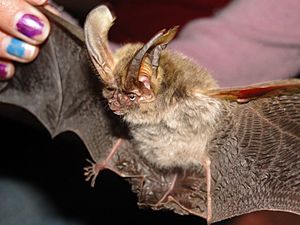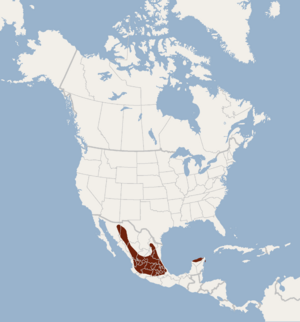Mexican big-eared bat facts for kids
Quick facts for kids Mexican big-eared bat |
|
|---|---|
 |
|
| In Michoacán, Mexico | |
| Conservation status | |
| Scientific classification | |
| Genus: |
Corynorhinus
|
| Species: |
mexicanus
|
 |
|
| Synonyms | |
|
Plecotus mexicanus (G.M. Allen, 1916) |
|
The Mexican big-eared bat (Corynorhinus mexicanus) is a special type of bat that lives only in Mexico. These bats are active at night and love to eat insects. You can easily spot them because of their super large ears, which are located right on their foreheads! If they get scared or caught, they often curl their ears to protect them.
Adult Mexican big-eared bats are usually brown. Younger bats, called juveniles, have a slightly different color, often a smoky brown. They also have small noses.
Contents
Where Mexican Big-Eared Bats Live
The Mexican big-eared bat is found only in Mexico. They live in many different parts of the country, from Sonora and Coahuila in the north all the way down to Michoacán and Yucatán in the south. They are not very common, especially in the southern areas.
These bats prefer to live in high, humid mountain areas. They especially like forests with pine and oak trees. However, you might also find them near other plants like sycamore, cottonwood, and agave. Since they are active at night, they need a safe place to rest during the day. They often choose open caves and old mine shafts as their daytime homes.
The Life Cycle of Mexican Big-Eared Bats
Studies show that male Mexican big-eared bats have one long breeding cycle each year. When this cycle happens depends on things like their body health and the environment around them, such as temperature and how much food is available.
The male bats' reproductive organs are smallest from February to April. They start to grow in May and become much larger by August, sometimes up to 40 times bigger than they were in April! The bats are in their best physical condition from May to June. This suggests that their breeding cycle is closely linked to how healthy and strong they are. Female bats usually give birth to just one baby bat at a time.
Protecting the Mexican Big-Eared Bat
In 1996, the Mexican big-eared bat was not considered to be in much danger. But by 2008, its status changed to "near threatened." This means that their numbers are going down, and they might soon become an endangered species if we don't help them.
The biggest danger to these bats comes from humans. People sometimes disturb their roosts (the places where they rest) or cause their habitats to be destroyed. Protecting their homes and leaving them undisturbed is very important for their survival.
See also
 In Spanish: Corynorhinus mexicanus para niños
In Spanish: Corynorhinus mexicanus para niños


